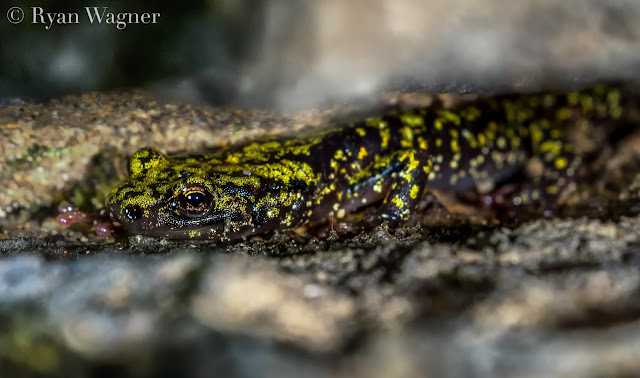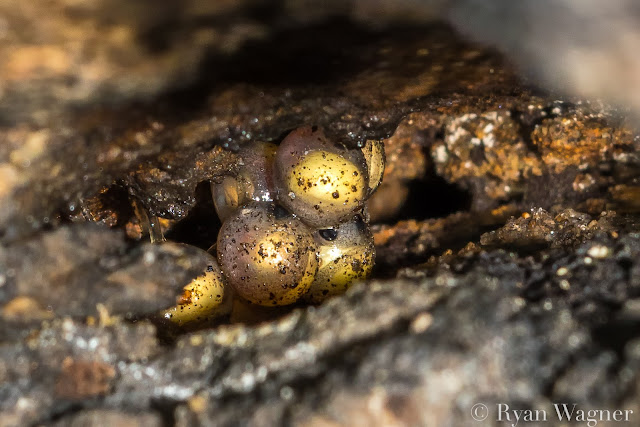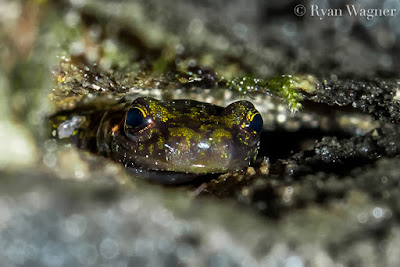The sun hadn't yet risen as we drove down 33 towards Charlene’s research site. I looked out into the blackness and yawned. The cloudy night sky was offset by the solid silhouettes of trees, giving the landscape two-tones of darkness. Red taillights and reflective traffic cones emerged out of the fog as if from nowhere. We turned off of the highway and instead of heading left towards Marcel’s site, Charlene turned right. We parked along the side of the road just off of the exit and stepped out into the chilly morning air. A light, blue outline of sky peeked above the trees and reflected against the wetland—the only hint that it was 6:30 in the morning and not midnight. I shivered and rubbed my arm as my breath formed little clouds of water vapor.
I had recently been hired by Charlene Hopkins, a PhD student at Ohio University studying the effects of roadways on amphibians. Like Marcel Weigand’s project (which you can read about HERE), Charlene’s study is situated around the Nelsonville Bypass. I met Charlene a few weeks into my freshman year at a research talk hosted by the OU Wildlife Club. Volunteering with her project was my first formal introduction to ecological research. The nature of Charlene’s study makes it perfect for someone like myself who is interested in seeing as much of Ohio’s biodiversity as possible.
Along the road, Charlene has constructed tarp fencing which directs and funnels amphibians and other small animals into a series of pitfall traps. She has recorded more than 30 species of native reptiles and amphibians dead or alive at her site. This includes eleven species of snakes, four species of turtles, nine species of frogs, and eight species of salamanders. She has even found a few dead copperheads, but, “no live ones yet,” she informed me, sounding disappointed.
 |
| A series of 4 pitfalls, each with a different front and top for amphibians to choose from. |
Small mammals are another commonly trapped vertebrate. In spring, Charlene puts a branch leaning up against the side of the pitfalls so that the shrews and voles can escape. If there is no way out, mammals are at risk of dying of hypothermia when it rains. Later in the season, when it is warm enough for the amphibians to start moving and breeding, shrews will kill anything trapped with them. This includes snakes, frogs, salamanders, and even other shrews. “They are like little zombies,” Charlene explained, “and will usually start by feeding on their prey’s brain.”
We donned headlamps and began our survey of the road for bodies. Amphibian bodies, that is. Each and every morning, weekday or weekend, rain or shine, Charlene heads out to her site to survey the road and check her traps. Impressive, to say the least. The Nelsonville Bypass is situated between a series of ephemeral wetlands and forested hillsides. The ideal amphibian highway—now trampled by vehicles.
The night before had been rainy; it wasn't long before we found our first casualty. The newt appeared nothing more than an orange smudge on the pavement. I suspect that even the most observant of herpetologists would have walked right past it. Charlene didn't even flinch. She nonchalantly waited for a car to pass, before walking out onto the road to scrape up the smeared body with her fingers. She spread the gelatinous innards around, exposing some of the newt's defining skin spots. “One red eft,” she said as she tossed the sludge into the grass. This might sound gross, but it is a reality of field research. To work with live animals, you must also be able to work with dead ones.
Red-spotted or eastern newts (Notophthalmus viridescens) exhibit a fascinating three-phase life-cycle which puts them at particular risk from roads. The newts hatch from eggs laid in a wetland or vernal pool. There, they grow as aquatic larvae, before emerging as tiny "red efts" in the fall. The lizard-like efts are fully terrestrial, venturing away from the wetland and into the surrounding forested hillsides (often crossing roads in the process). The efts are bright orange in coloration and are easily spotted wandering around the forest floor. This boldness is due to the extremely potent tetrodotoxin excreted by glands in their skin. The efts will grow for the next 2-3 years before returning to the wetland and metamorphosing into the adult stage (forcing them to cross roads again). Fully grown newts are entirely aquatic, with a rudder-shaped tail used for swimming.
We continued walking, scanning the road with our headlamps, trying to pick out the minute reflections from squished bodies. On days when it has rained recently, the amphibians will be out in force. We paused every few feet to remove entrails and record data. During heavy migration events in the spring and fall, Charlene might see somewhere in the vicinity of 800 amphibians dead on the road in a single night. It is truly shocking how much damage one road can do. Seeing DOR (dead on road) animals is a reality for all herpers. Reptiles and amphibians are slow and vulnerable, making them particularly susceptible to collisions with vehicles. Charlene’s site isn't unique. Countless roads throughout Ohio (and the world) account for untold numbers of amphibian deaths every year.
Systematic surveys of amphibian road mortality are rare—for obvious reasons. Prior to Charlene taking over the project, surveys had been done in cars. Driving at any reasonable speed would mean missing nearly all of the tiny bodies. It wasn't until she started walking the mile-long stretch of road every morning that the true impact was realized. In order to prevent further road mortality, mitigation structures were clearly an imperative.
 |
| A tiny red eft found on the road. One of the few lucky survivors. |
 |
| An adult red-spotted newt. |
Systematic surveys of amphibian road mortality are rare—for obvious reasons. Prior to Charlene taking over the project, surveys had been done in cars. Driving at any reasonable speed would mean missing nearly all of the tiny bodies. It wasn't until she started walking the mile-long stretch of road every morning that the true impact was realized. In order to prevent further road mortality, mitigation structures were clearly an imperative.
The Ohio Department of Transportation, which funds Charlene's research, has already installed two amphibian tunnels beneath the road. Charlene's findings, however, have shown that not only are these tunnels built in the wrong places, but they are also poorly designed for amphibian use. The bulk of amphibian movement occurs upstream of the tunnels. Even if frogs and salamanders did have the option to utilize the structures, few would risk entering. The tunnels are dark and narrow, and don't provide a view of the other side. Would you want to venture into a huge, black cavern that might not even take you where you want to go?
Using Charlene's findings, ODOT has recently finalized plans to build a new amphibian tunnel beneath the road. This tunnel will take into account where most of the amphibians are crossing. It will be much wider than the previously-built tunnels, as well as provide a level view to the other side. The top will be grated, allowing sunlight to reach the soil-covered floor. This tunnel will not eliminate road mortality for amphibians, but—if all goes as planned—it will greatly reduce it. An encouraging step towards ensuring the long-term survival of our native herpetofauna.




















